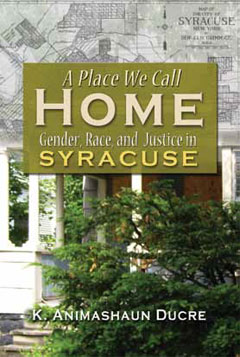Author Spotlight: K. Animashaun Ducre
Book: A Place We Call Home: Gender, Race, and Justice in Syracuse
K. Animashaun Ducre is a dedicate d advocate for environmental justice with four years of Greenpeace experience working as a toxics campaigner. She received her PhD in environmental justice at the University of Michigan, Ann Arbor. Currently, she is an assistant professor in the Department of African American Studies at Syracuse University. Her new SU Press book, A Place We Call Home: Gender, Race, and Justice in Syracuse was published this month and is a wonderful addition to the Syracuse Studies on Peace and Conflict Resolution series.
d advocate for environmental justice with four years of Greenpeace experience working as a toxics campaigner. She received her PhD in environmental justice at the University of Michigan, Ann Arbor. Currently, she is an assistant professor in the Department of African American Studies at Syracuse University. Her new SU Press book, A Place We Call Home: Gender, Race, and Justice in Syracuse was published this month and is a wonderful addition to the Syracuse Studies on Peace and Conflict Resolution series.
Tell us about your new book, A Place We Call Home.
“My book is part memoir/part research on Black women who lived in depressed urban environments and how they cope.”
Have you always had an interest for environmental justice? What led you to the field?
“I have always had an interest in social justice. As a child growing up in Washington DC and Maryland, my family and I were heavily involved in helping the homeless. Later, when I went to college, I worked on race relations during the height of the Rodney King beating and the acquittal of the officers involved. After graduation, my interest broadened to include both environmental rights and civil rights when I began to work for Greenpeace, an international environmental organization. My work with Greenpeace led to my scholarship and advocacy on environmental justice.”
What was the biggest challenge you encountered while writing this book?
“The biggest challenge in writing this book, aside from carving out time from my teaching and other faculty duties, was finding the courage to present my own voice. Most academic research relies upon a degree of objectivity and a presumption of distance between the researcher and the subject. However, the reader knows by the first few sentences of my book that my life and experience are a significant part of the narrative. Adopting a Black feminist perspective in my research and writing gave me the confidence to present my work in this manner. Writers like bell hooks and the late Audre Lorde were influential in my decision to present my work in this manner.”
What types of research did you conduct before writing this case study? How many years of research?
“I am versed in both quantitative and qualitative research. My dissertation, written in 2005 is based solely on spatial statistics. When I came to Syracuse, I relied upon the resources available in the Department of African American studies to hone my qualitative skills. We are the only department at Syracuse University to house our very own library (the Martin Luther King, Jr.) and specialist librarian, as well as operate our own visual and cultural arts center (the Community Folk Art Center). The Community Folk Art Center hosted the photography exhibition that arose from this research in 2007.”
What did you find most eye-opening about your research?
“I was surprised by how well the participants in the project were familiar with maps. In my experience, understanding maps presents a challenge.”
Describe your favorite experience while writing A Place We Call Home?
“I look forward to the presentation of the participants’ photos each during the project. Some of the photos are featured in the book. It was interesting to see each image and to listen to how each woman presented the photo. Often, the image was not enough to understand the concept – you had to hear each woman discuss the elements of the photo that appealed to her.”
What is the most beneficial aspect of your occupation?
“I like teaching. I like challenging my students to think critically about society. I also like research – asking questions and seeking answers. I have worked on different dimensions of environmental justice – from calculating the amount of air pollution with statistics, to browsing through old plantation records at an archive, to analyzing photographs by the women in this Photovoice project.”
What can we expect from you next?
“Speaking of old plantation records, I have accumulating information about a sugar plantation in Southern Louisiana that later was bought by a chemical manufacturer. I want to highlight this connection between plantation-to-plant and this particular site’s effect on the Black community that surrounds it. I think there are some interesting parallels between the oppression of slavery and the oppression of a polluting industry. I’m also working on edited volume that looks at environmental injustice and schooling – my chapter focuses on case studies where hazardous industry are located near elementary schools and we can do to prohibit this.”
For more information on K. Animashaun Ducre’s new book, A Place We Call Home, visit the Syracuse University Press website or attend her book talk on Thursday, February 7th at the Community Folk Art Center in Syracuse, NY. See the Events page for more details on this upcoming event.
This entry was posted on January 15, 2013 by syrupress. It was filed under Author Spotlight and was tagged with Authors, Ducre, Fall 2012, Peace and Conflict Resolution, Syracuse University.

Leave a comment